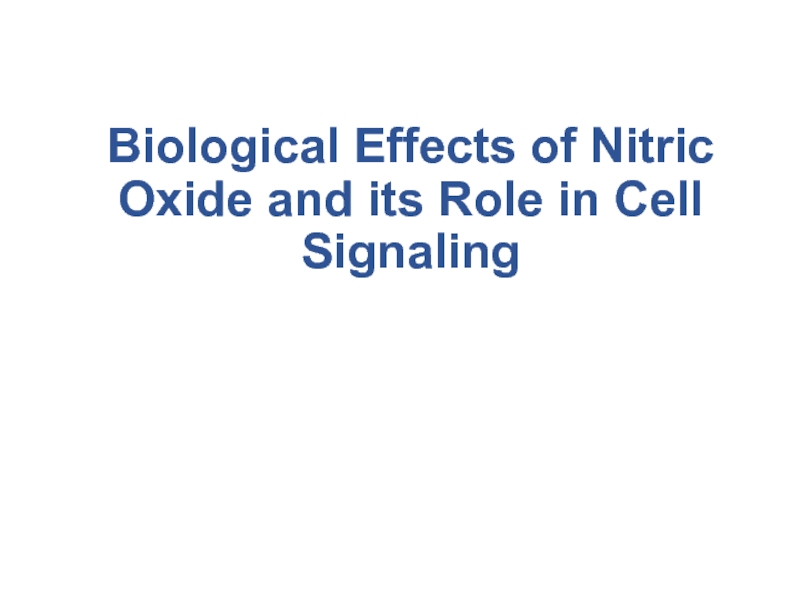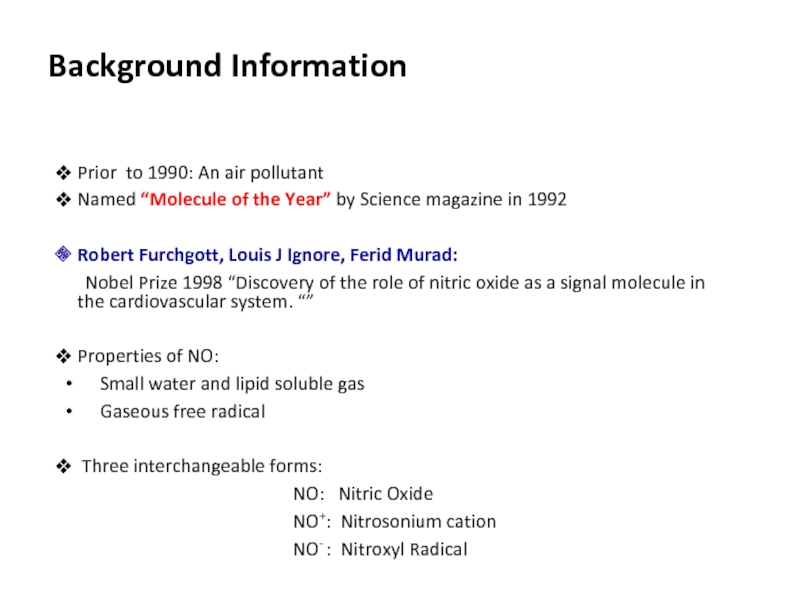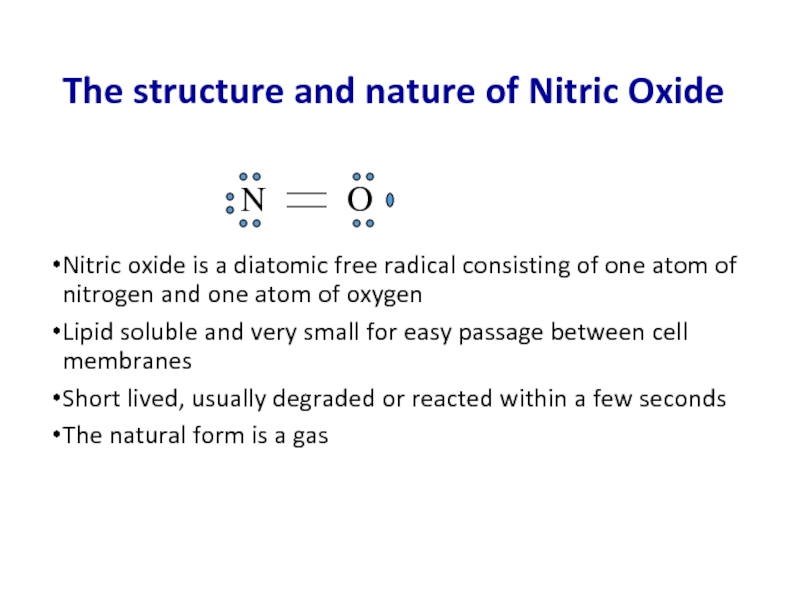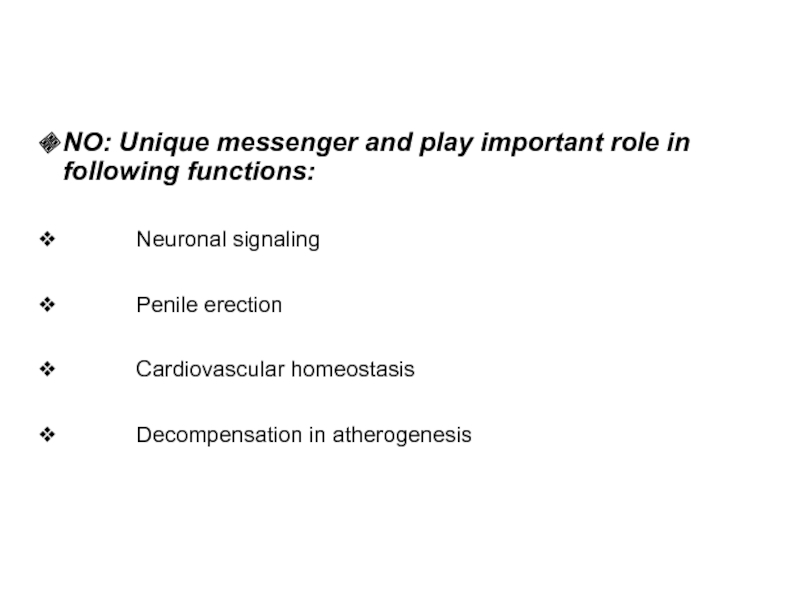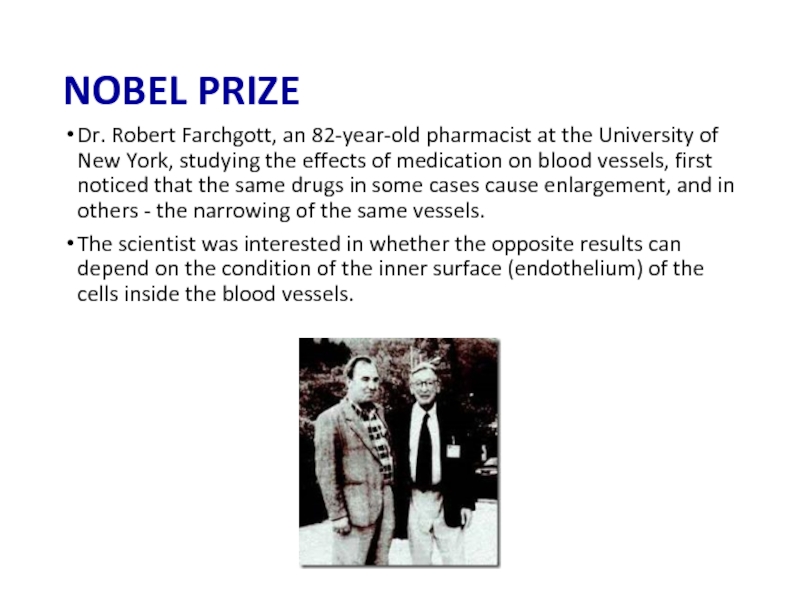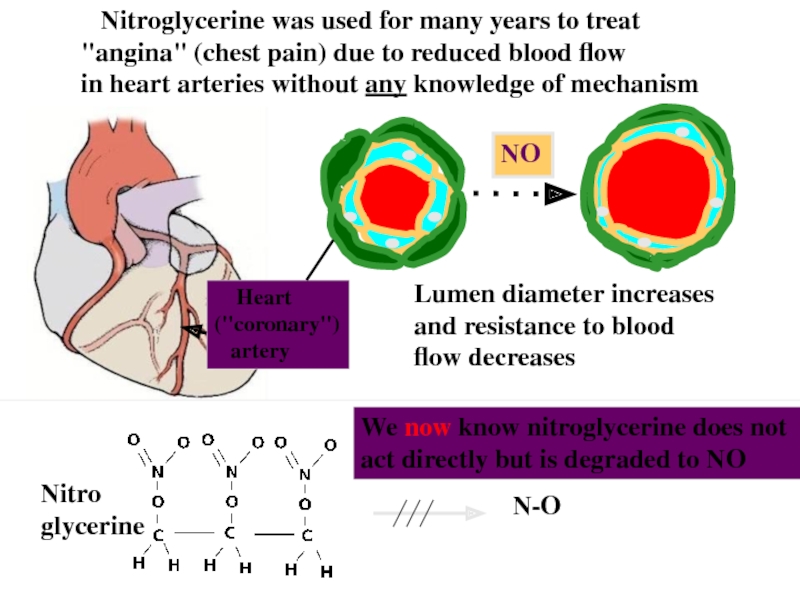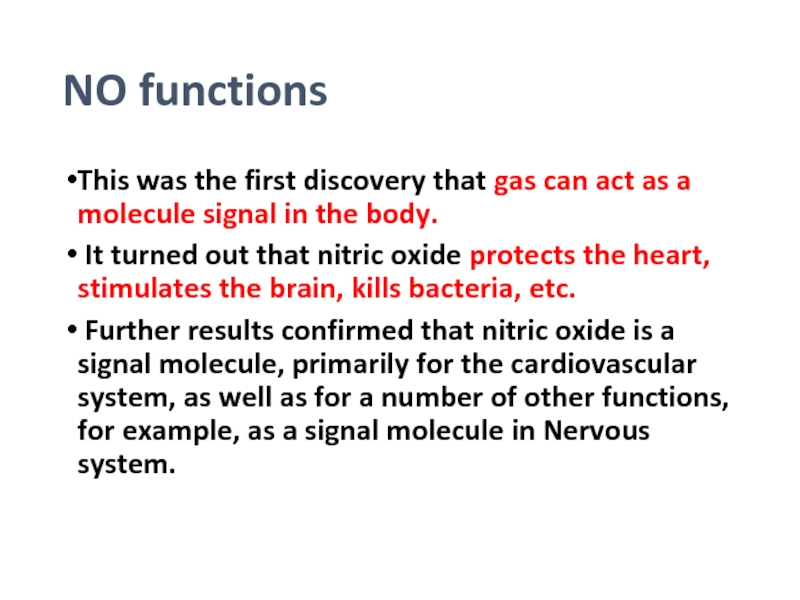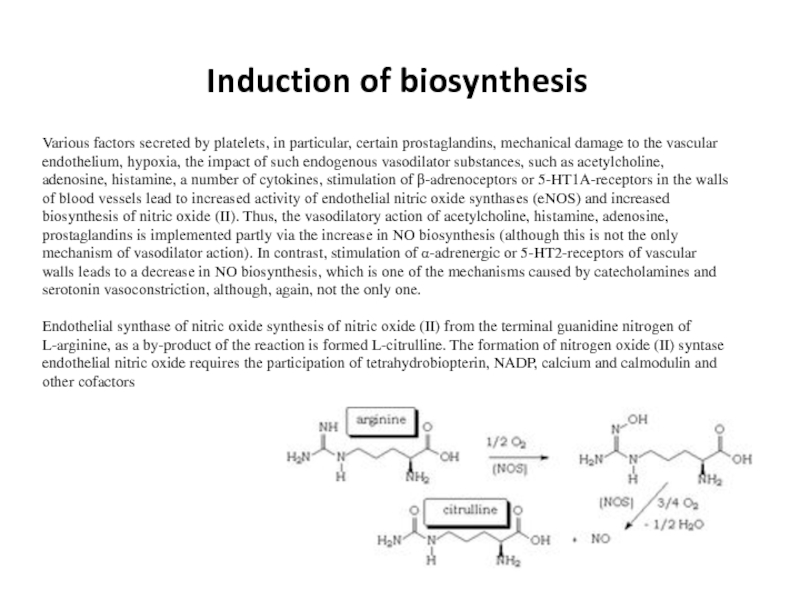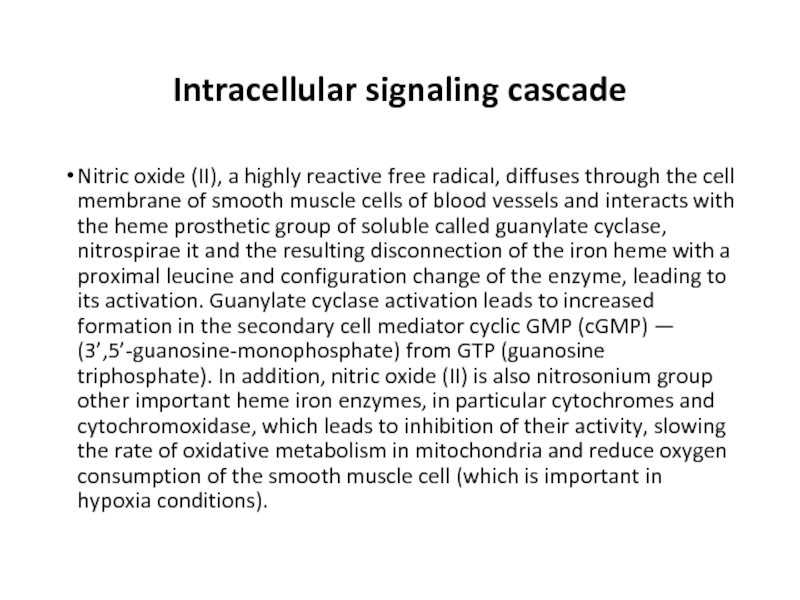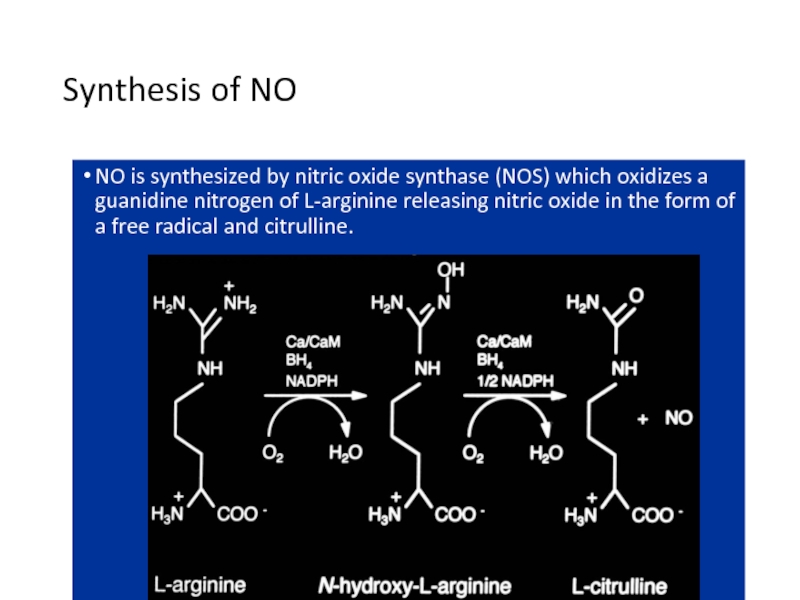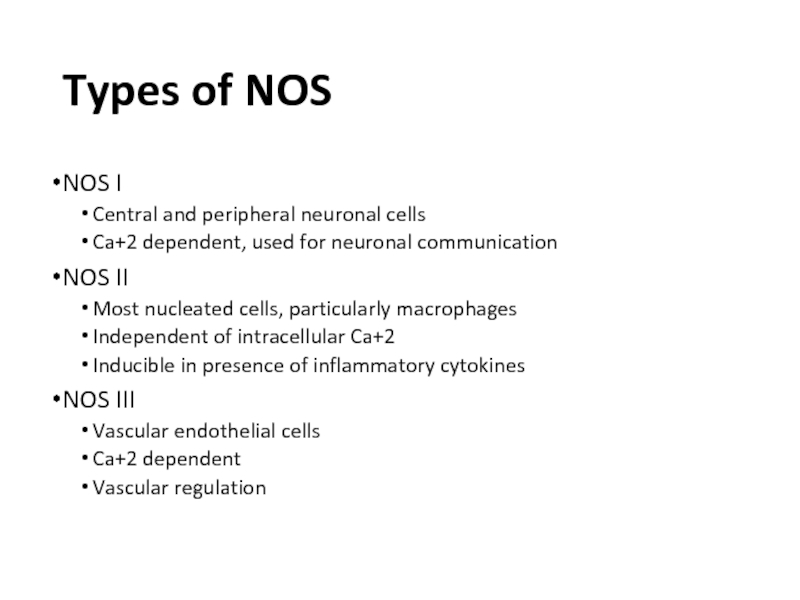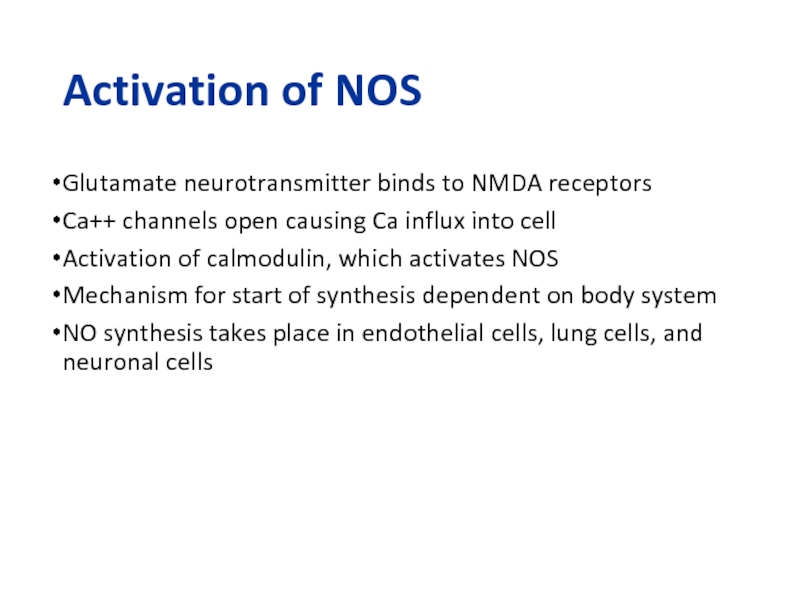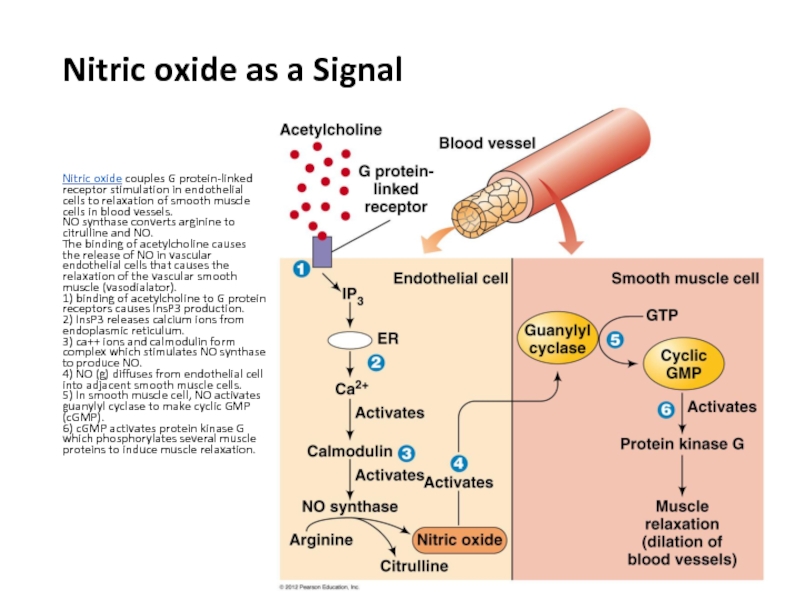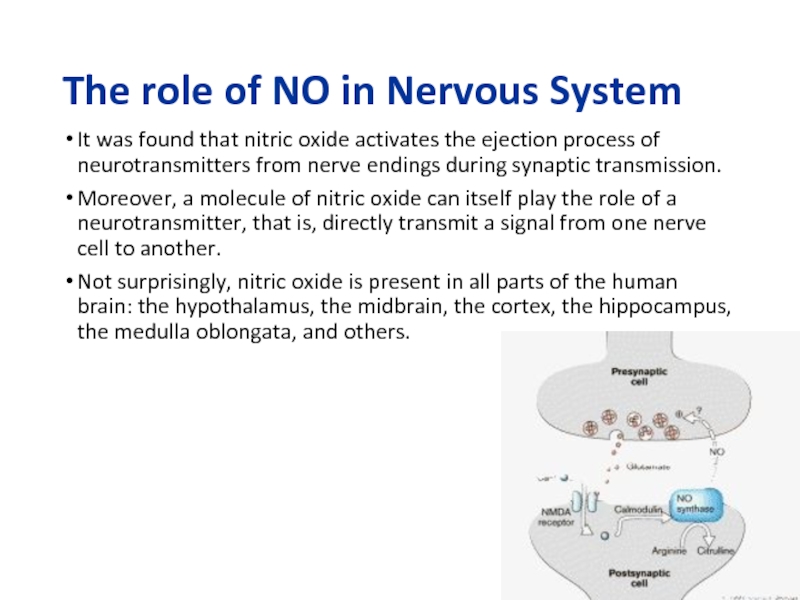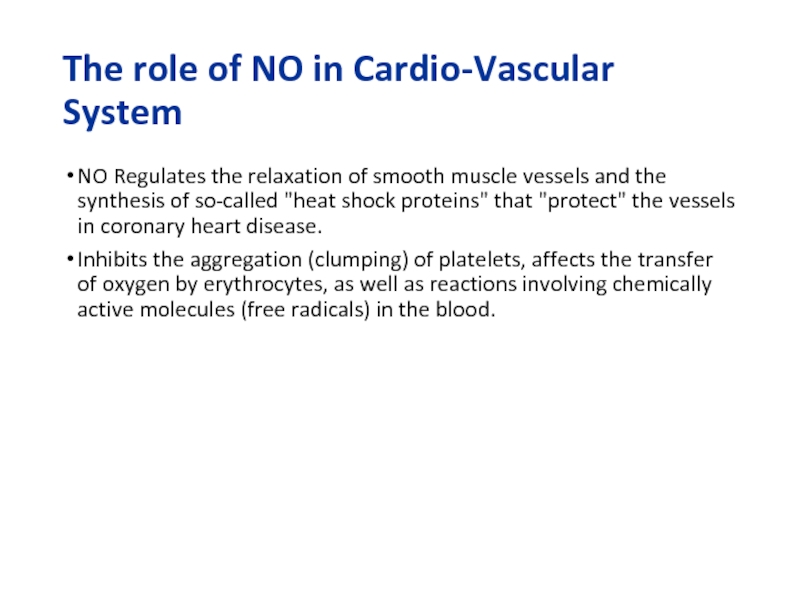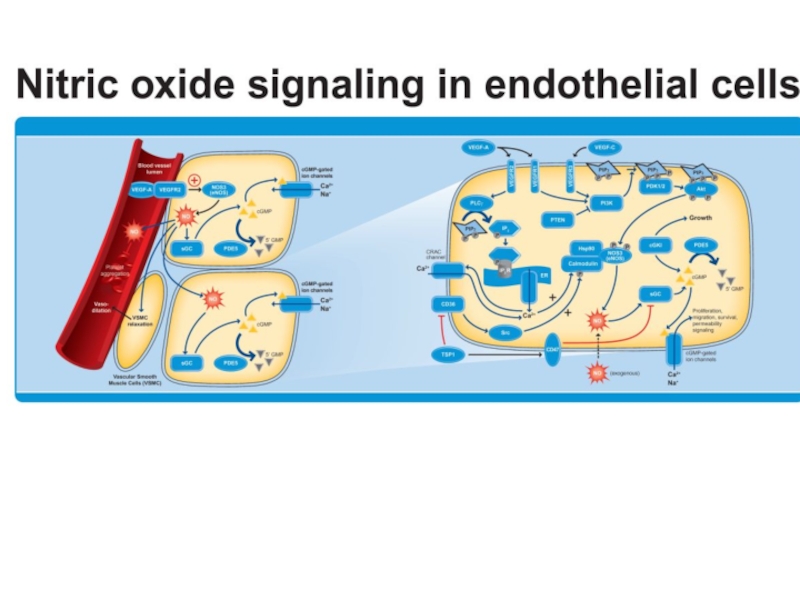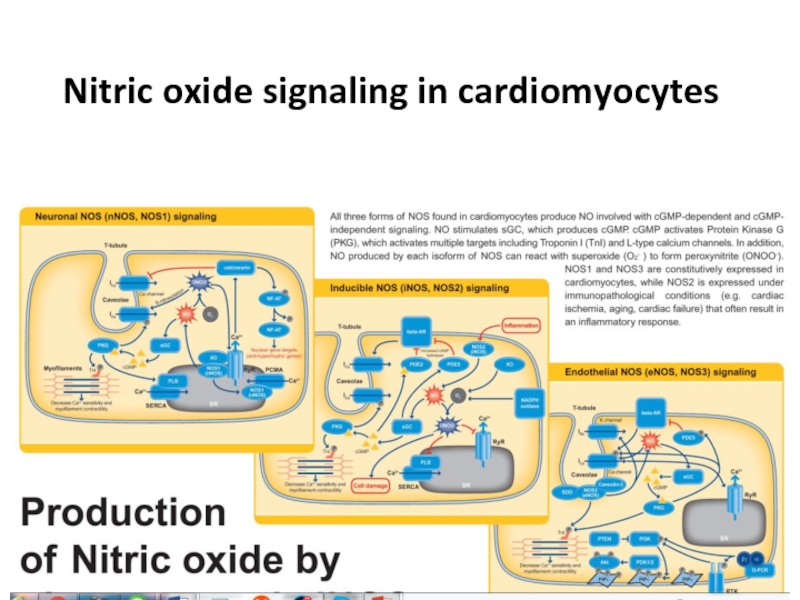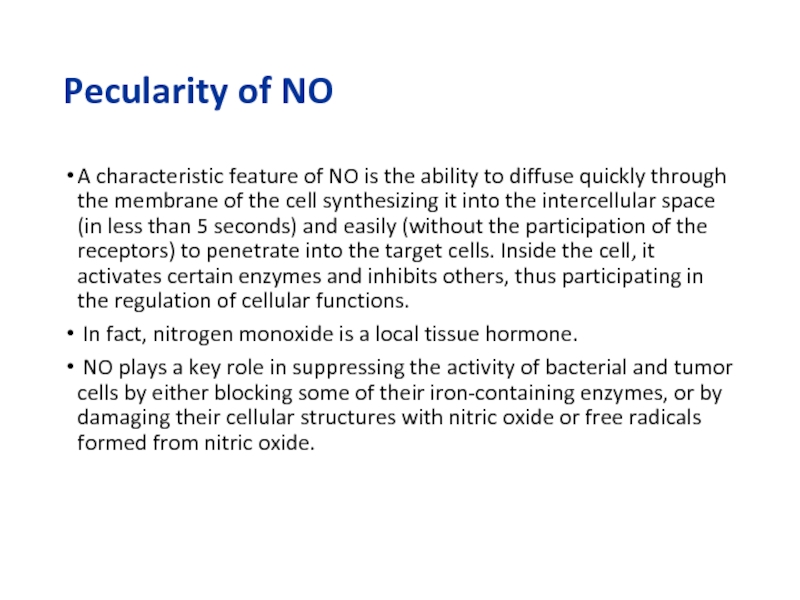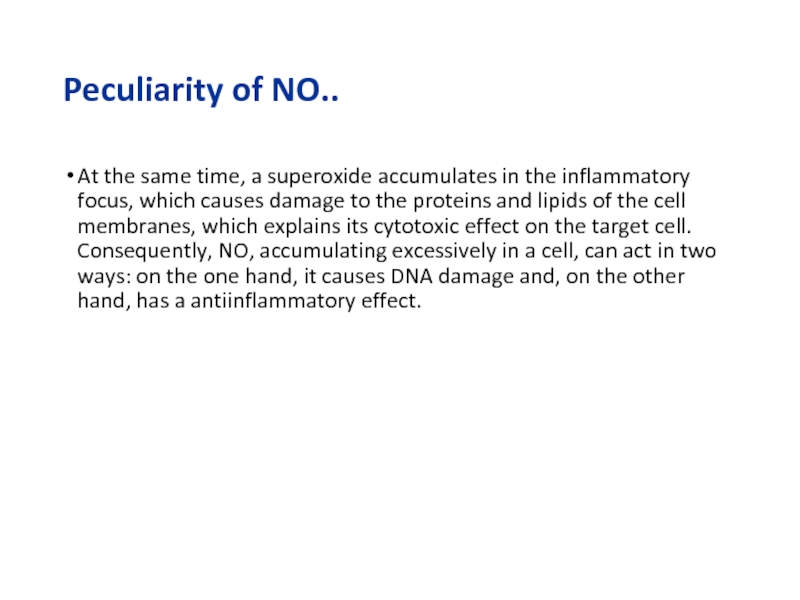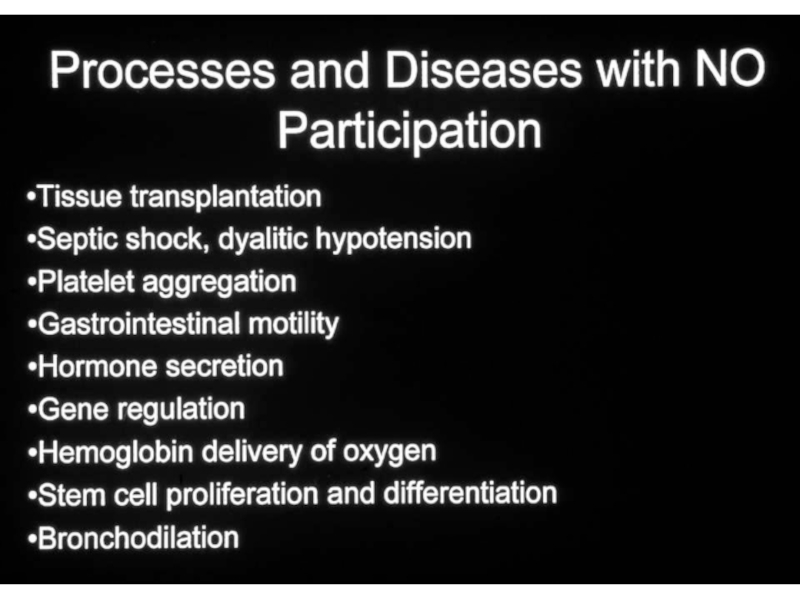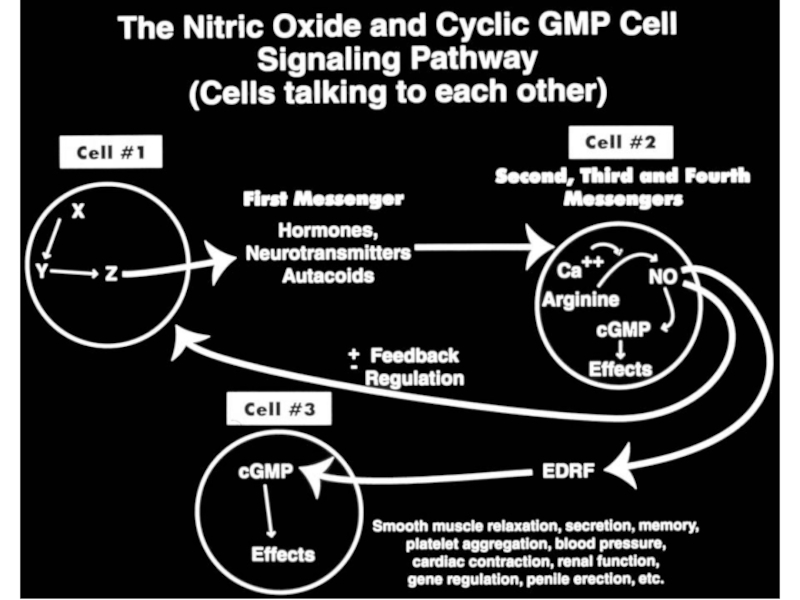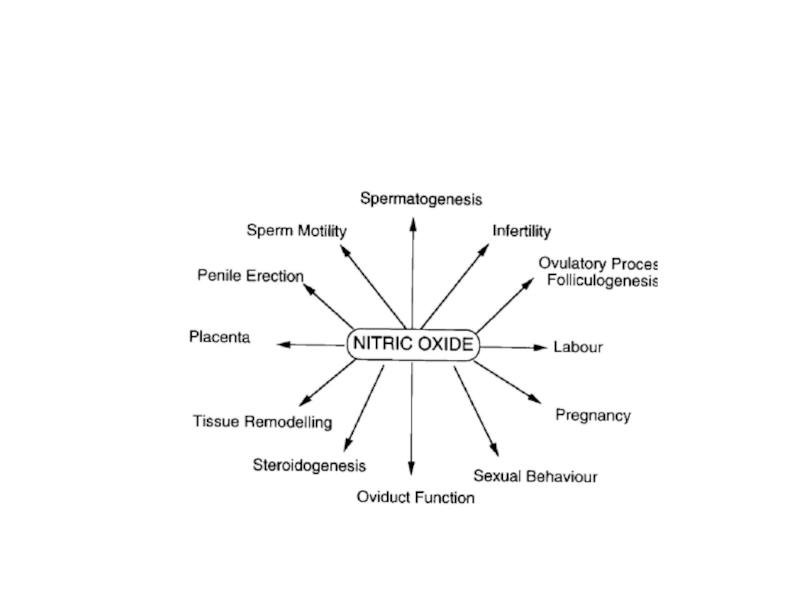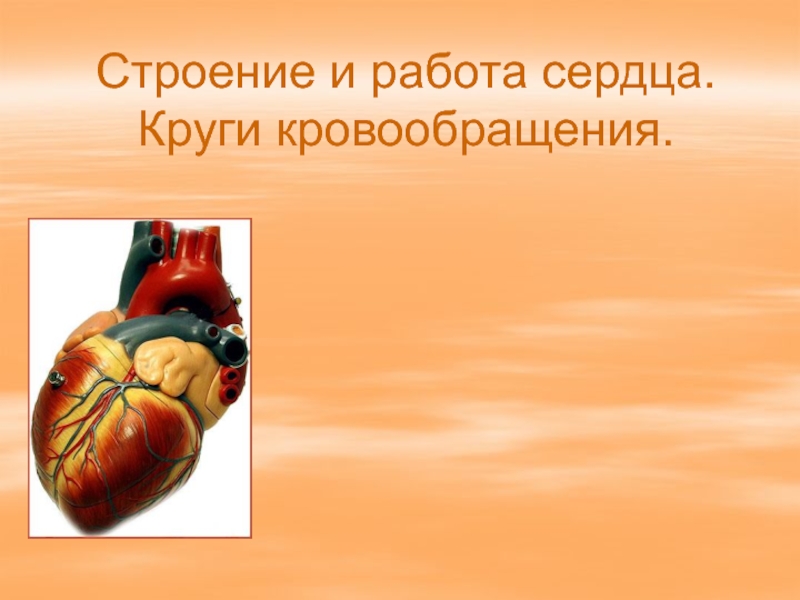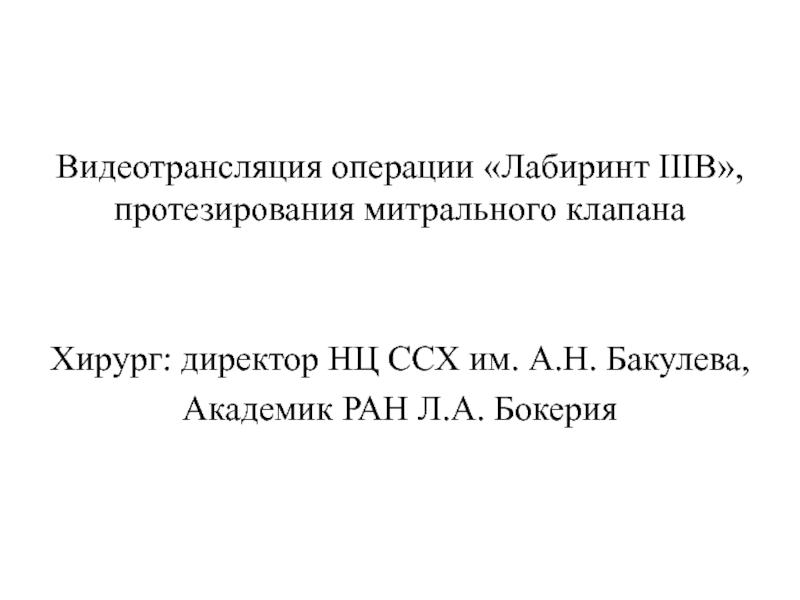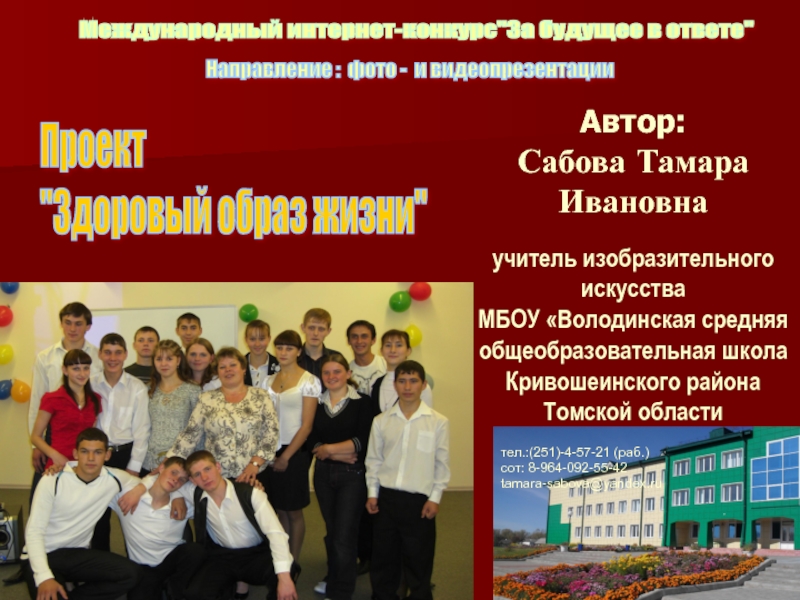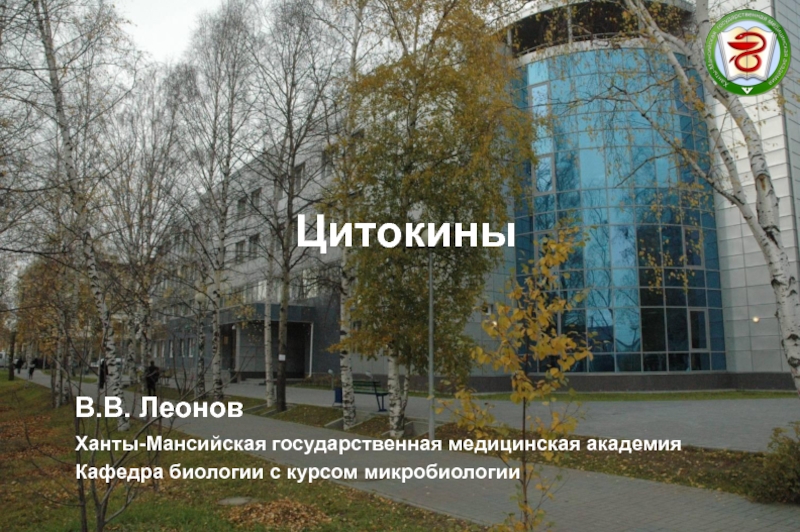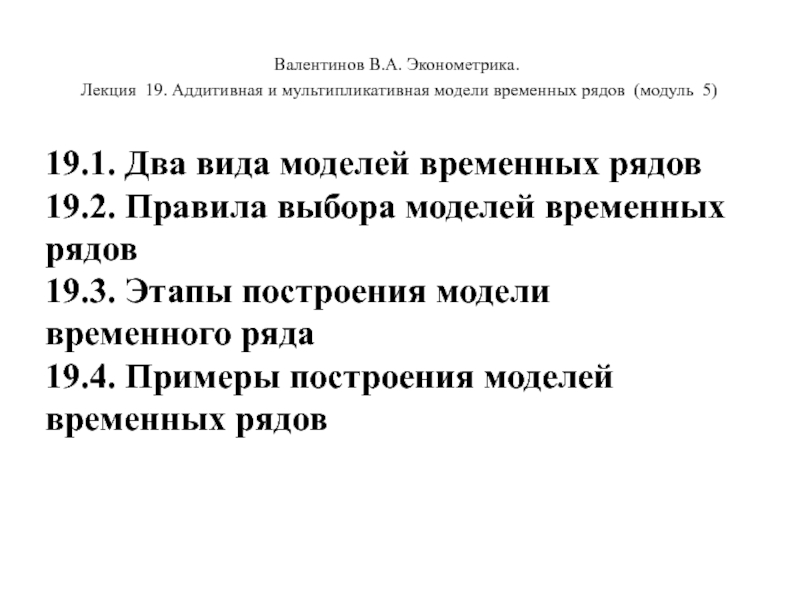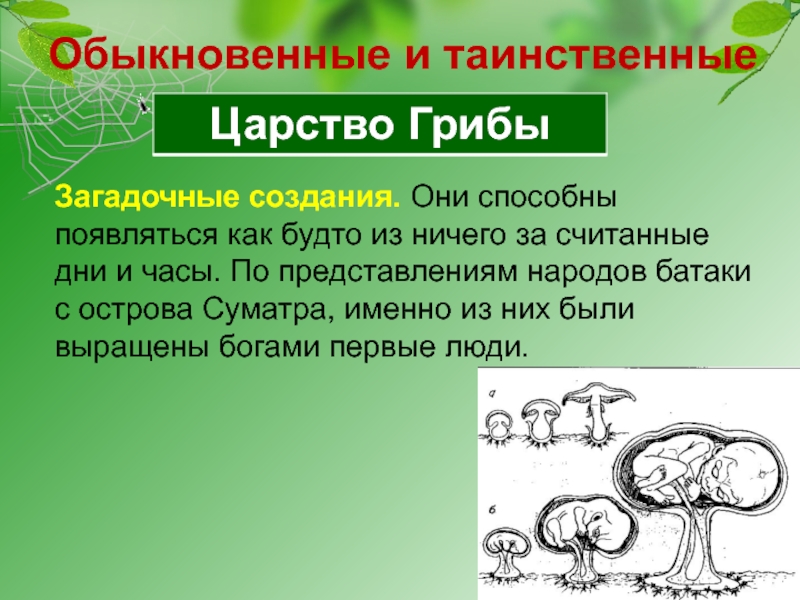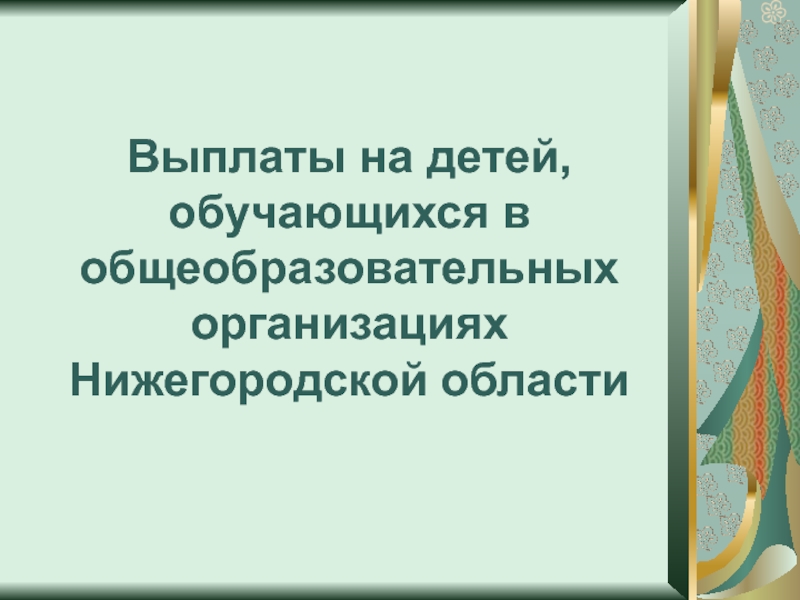Разделы презентаций
- Разное
- Английский язык
- Астрономия
- Алгебра
- Биология
- География
- Геометрия
- Детские презентации
- Информатика
- История
- Литература
- Математика
- Медицина
- Менеджмент
- Музыка
- МХК
- Немецкий язык
- ОБЖ
- Обществознание
- Окружающий мир
- Педагогика
- Русский язык
- Технология
- Физика
- Философия
- Химия
- Шаблоны, картинки для презентаций
- Экология
- Экономика
- Юриспруденция
Biological Effects of Nitric Oxide and its Role in Cell Signaling
Содержание
- 1. Biological Effects of Nitric Oxide and its Role in Cell Signaling
- 2. What is Nitric Oxide?First described in 1979
- 3. Background InformationPrior to 1990: An air pollutantNamed
- 4. The structure and nature of Nitric OxideNitric
- 5. NO: Unique messenger and play important role
- 6. NOBEL PRIZEDr. Robert Farchgott, an 82-year-old pharmacist
- 7. NOBEL PRIZEIn 1980, in a simple experiment
- 8. NOBEL PRIZE62-year-old pharmacologist Ferid Murad from the
- 9. Nitroglycerine was used for many
- 10. NO functionsThis was the first discovery that
- 11. Induction of biosynthesisVarious factors secreted by platelets,
- 12. Intracellular signaling cascadeNitric oxide (II), a highly
- 13. Synthesis of NONO is synthesized by nitric
- 14. Nitric Oxide Synthase Isoforms
- 15. Types of NOSNOS ICentral and peripheral neuronal
- 16. Http://www.kumc.edu/research/medicine/biochemistry/bioc800/sig02-06.htm
- 17. Activation of NOSGlutamate neurotransmitter binds to NMDA
- 18. ArgNOGTPcGMP5) NO binds to Guanylyl cyclaseRelaxation of
- 19. Nitric oxide as a Signal Nitric
- 20. The role of NO in Nervous SystemIt
- 21. The role of NO in Cardio-Vascular SystemNO
- 22. Слайд 22
- 23. Nitric oxide signaling in cardiomyocytes
- 24. The role of NO in Immune SystemThe
- 25. Pecularity of NOA characteristic feature of NO
- 26. Peculiarity of NO..At the same time, a
- 27. Pecularity of NO..Nitric oxide can initiate the
- 28. Слайд 28
- 29. Слайд 29
- 30. Слайд 30
- 31. Слайд 31
- 32. Слайд 32
- 33. Слайд 33
- 34. Скачать презентанцию
What is Nitric Oxide?First described in 1979 as a potent relaxant of peripheral vascular smooth muscle. Used by the body as a signaling molecule.Serves different functions depending on body system. i.e.
Слайды и текст этой презентации
Слайд 2What is Nitric Oxide?
First described in 1979 as a potent
relaxant of peripheral vascular smooth muscle.
Used by the body
as a signaling molecule.Serves different functions depending on body system. i.e. neurotransmitter, vasodilator, bactericide.
Environmental Pollutant
First gas known to act as a biological messenger
Слайд 3Background Information
Prior to 1990: An air pollutant
Named “Molecule of the
Year” by Science magazine in 1992
Robert Furchgott, Louis J Ignore,
Ferid Murad:Nobel Prize 1998 “Discovery of the role of nitric oxide as a signal molecule in the cardiovascular system. “”
Properties of NO:
Small water and lipid soluble gas
Gaseous free radical
Three interchangeable forms:
NO: Nitric Oxide
NO+: Nitrosonium cation
NO- : Nitroxyl Radical
Слайд 4The structure and nature of Nitric Oxide
Nitric oxide is a
diatomic free radical consisting of one atom of nitrogen and
one atom of oxygenLipid soluble and very small for easy passage between cell membranes
Short lived, usually degraded or reacted within a few seconds
The natural form is a gas
N
O
Слайд 5
NO: Unique messenger and play important role in following functions:
Neuronal signaling
Penile erectionCardiovascular homeostasis
Decompensation in atherogenesis
Слайд 6NOBEL PRIZE
Dr. Robert Farchgott, an 82-year-old pharmacist at the University
of New York, studying the effects of medication on blood
vessels, first noticed that the same drugs in some cases cause enlargement, and in others - the narrowing of the same vessels.The scientist was interested in whether the opposite results can depend on the condition of the inner surface (endothelium) of the cells inside the blood vessels.
Слайд 7NOBEL PRIZE
In 1980, in a simple experiment with acetilcholine, he
showed that this substance dilates the blood vessels in those
cases when the wall of the vessels is not damaged.R. Farchgotta concluded that intact endothelial cells produce an unknown signal hitherto relaxing the smooth musculature of the vessels.
This scientist called the molecule EDRF, which meant "endothelium-receiving-distributing factor." In search of an unknown signal molecule,
In search of an unknown signal molecule, independently of R. Farchgott, Dr. Louis Ignarro, a 57-year-old scientist from the University of California at Los Angeles (UCLA), took part. In search of the chemical nature of EDRF, L. Ignarro conducted a brilliant series of studies and in 1986 came to the conclusion that EDRF is identical to nitric oxide.
Слайд 8NOBEL PRIZE
62-year-old pharmacologist Ferid Murad from the University of Texas
Medical School in Houston analyzed the pharmacological effect of giving
nitroglycerin and other related vasodilators.In 1977, he established that these substances release nitric oxide, which expands the smooth muscle of cells.
The idea that gas can regulate the most important cellular functions, seized him, but at that time he did not have sufficient experimental justifications to confirm this idea.
Слайд 9 Nitroglycerine was used for many years to treat
"angina"
(chest pain) due to reduced blood flow
in heart arteries without
any knowledge of mechanismLumen diameter increases
and resistance to blood
flow decreases
Heart
("coronary")
artery
NO
Слайд 10NO functions
This was the first discovery that gas can act
as a molecule signal in the body.
It turned out
that nitric oxide protects the heart, stimulates the brain, kills bacteria, etc.Further results confirmed that nitric oxide is a signal molecule, primarily for the cardiovascular system, as well as for a number of other functions, for example, as a signal molecule in Nervous system.
Слайд 11Induction of biosynthesis
Various factors secreted by platelets, in particular, certain
prostaglandins, mechanical damage to the vascular endothelium, hypoxia, the impact
of such endogenous vasodilator substances, such as acetylcholine, adenosine, histamine, a number of cytokines, stimulation of β-adrenoceptors or 5-HT1A-receptors in the walls of blood vessels lead to increased activity of endothelial nitric oxide synthases (eNOS) and increased biosynthesis of nitric oxide (II). Thus, the vasodilatory action of acetylcholine, histamine, adenosine, prostaglandins is implemented partly via the increase in NO biosynthesis (although this is not the only mechanism of vasodilator action). In contrast, stimulation of α-adrenergic or 5-HT2-receptors of vascular walls leads to a decrease in NO biosynthesis, which is one of the mechanisms caused by catecholamines and serotonin vasoconstriction, although, again, not the only one.Endothelial synthase of nitric oxide synthesis of nitric oxide (II) from the terminal guanidine nitrogen of L-arginine, as a by-product of the reaction is formed L-citrulline. The formation of nitrogen oxide (II) syntase endothelial nitric oxide requires the participation of tetrahydrobiopterin, NADP, calcium and calmodulin and other cofactors
Слайд 12Intracellular signaling cascade
Nitric oxide (II), a highly reactive free radical,
diffuses through the cell membrane of smooth muscle cells of
blood vessels and interacts with the heme prosthetic group of soluble called guanylate cyclase, nitrospirae it and the resulting disconnection of the iron heme with a proximal leucine and configuration change of the enzyme, leading to its activation. Guanylate cyclase activation leads to increased formation in the secondary cell mediator cyclic GMP (cGMP) — (3’,5’-guanosine-monophosphate) from GTP (guanosine triphosphate). In addition, nitric oxide (II) is also nitrosonium group other important heme iron enzymes, in particular cytochromes and cytochromoxidase, which leads to inhibition of their activity, slowing the rate of oxidative metabolism in mitochondria and reduce oxygen consumption of the smooth muscle cell (which is important in hypoxia conditions).Слайд 13Synthesis of NO
NO is synthesized by nitric oxide synthase (NOS)
which oxidizes a guanidine nitrogen of L-arginine releasing nitric oxide
in the form of a free radical and citrulline.Слайд 15Types of NOS
NOS I
Central and peripheral neuronal cells
Ca+2 dependent, used
for neuronal communication
NOS II
Most nucleated cells, particularly macrophages
Independent of intracellular
Ca+2Inducible in presence of inflammatory cytokines
NOS III
Vascular endothelial cells
Ca+2 dependent
Vascular regulation
Слайд 17Activation of NOS
Glutamate neurotransmitter binds to NMDA receptors
Ca++ channels open
causing Ca influx into cell
Activation of calmodulin, which activates NOS
Mechanism
for start of synthesis dependent on body systemNO synthesis takes place in endothelial cells, lung cells, and neuronal cells
Слайд 18Arg
NO
GTP
cGMP
5) NO binds to Guanylyl cyclase
Relaxation of smooth muscle
NO
Smooth muscle
cell blood vessel wall
4) NO diffuses
across membranes
2) ACh binds
to receptors on endothelial cells
3) Activate NO synthase
1) Stimulated nerve releases
Acetylcholine(ACh) at Nerve terminal
Nitric Oxide Signaling
Слайд 19Nitric oxide as a Signal
Nitric oxide couples G protein-linked receptor stimulation
in endothelial cells to relaxation of smooth muscle cells in
blood vessels. NO synthase converts arginine to citrulline and NO. The binding of acetylcholine causes the release of NO in vascular endothelial cells that causes the relaxation of the vascular smooth muscle (vasodialator). 1) binding of acetylcholine to G protein receptors causes InsP3 production. 2) InsP3 releases calcium ions from endoplasmic reticulum. 3) ca++ ions and calmodulin form complex which stimulates NO synthase to produce NO. 4) NO (g) diffuses from endothelial cell into adjacent smooth muscle cells. 5) In smooth muscle cell, NO activates guanylyl cyclase to make cyclic GMP (cGMP). 6) cGMP activates protein kinase G which phosphorylates several muscle proteins to induce muscle relaxation.Слайд 20The role of NO in Nervous System
It was found that
nitric oxide activates the ejection process of neurotransmitters from nerve
endings during synaptic transmission.Moreover, a molecule of nitric oxide can itself play the role of a neurotransmitter, that is, directly transmit a signal from one nerve cell to another.
Not surprisingly, nitric oxide is present in all parts of the human brain: the hypothalamus, the midbrain, the cortex, the hippocampus, the medulla oblongata, and others.
Слайд 21The role of NO in Cardio-Vascular System
NO Regulates the relaxation
of smooth muscle vessels and the synthesis of so-called "heat
shock proteins" that "protect" the vessels in coronary heart disease.Inhibits the aggregation (clumping) of platelets, affects the transfer of oxygen by erythrocytes, as well as reactions involving chemically active molecules (free radicals) in the blood.
Слайд 24The role of NO in Immune System
The activation of cells
involved in the immune response - macrophages and neutrophils -
is accompanied by the release of these cells by nitric oxide.Слайд 25Pecularity of NO
A characteristic feature of NO is the ability
to diffuse quickly through the membrane of the cell synthesizing
it into the intercellular space (in less than 5 seconds) and easily (without the participation of the receptors) to penetrate into the target cells. Inside the cell, it activates certain enzymes and inhibits others, thus participating in the regulation of cellular functions.In fact, nitrogen monoxide is a local tissue hormone.
NO plays a key role in suppressing the activity of bacterial and tumor cells by either blocking some of their iron-containing enzymes, or by damaging their cellular structures with nitric oxide or free radicals formed from nitric oxide.
Слайд 26Peculiarity of NO..
At the same time, a superoxide accumulates in
the inflammatory focus, which causes damage to the proteins and
lipids of the cell membranes, which explains its cytotoxic effect on the target cell. Consequently, NO, accumulating excessively in a cell, can act in two ways: on the one hand, it causes DNA damage and, on the other hand, has a antiinflammatory effect.Слайд 27Pecularity of NO..
Nitric oxide can initiate the formation of blood
vessels. In the case of myocardial infarction, nitric oxide plays
a positive role, as it induces a new vascular growth, but in cancer, the same process causes the development of tumors, promoting the nutrition and growth of cancer cells.On the other hand, as a result, the delivery of nitric oxide to tumor cells is improved. DNA damage due to NO is one of the reasons for the development of apoptosis (the programmed process of cellular "suicide", aimed at removing cells that have lost their functions).
In the experiments, there was deamination of deoxynucleosides, deoxynucleotides and undamaged DNA upon exposure to a solution saturated with NO.
This process is responsible for increasing the sensitivity of cells to alkylating agents and ionizing radiation, which is used in anticancer therapy.
Слайд 33
Conclusion
NO is a universal messenger molecule
It is involved
in a wide variety of pathophysiogical and biochemical reactions.In summary NO is involved in regulation of B.P., prevention of aggregation and adhesion of platelets, promotion of penile erection.
Other way to increase active concentration of endogenous NO such as by prolonging its half life of duration of its actions.
NO donating compounds can be used as replacement therapy to treat its impaired production
NO also as therapeutic potential for Ischemic CVS diseases, pulmonary hypertension associated with cardiac and respiratory diseases.
They are far from ideal because of the associated side effect mainly due to the catabolism of NO into NO2
Therefore a technology to regulate in vivo synthesis of NO by genetic manipulation would be a welcome move.
